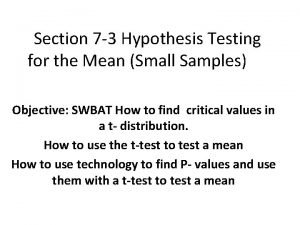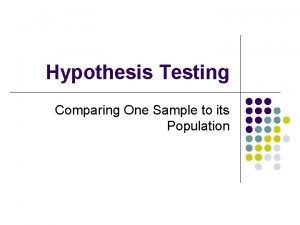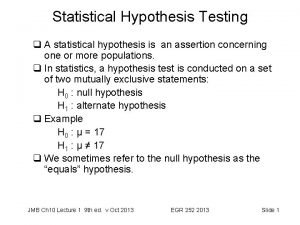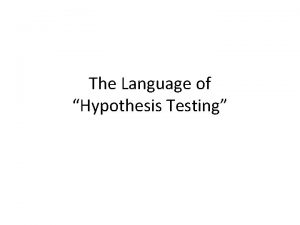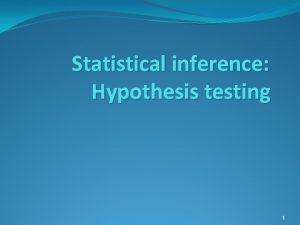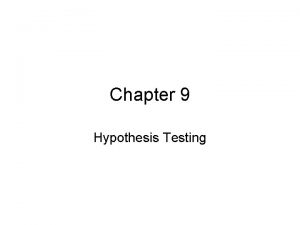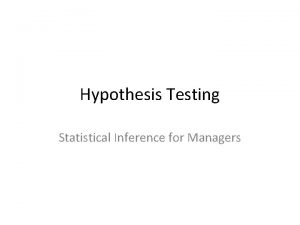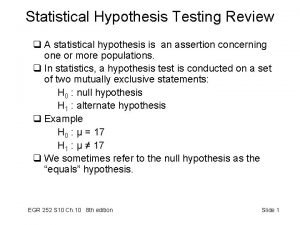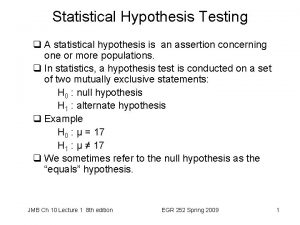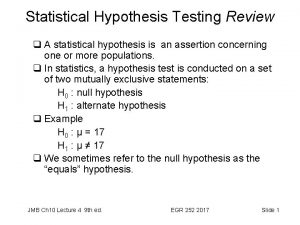Statistical Hypothesis Testing Part 3 q A statistical








- Slides: 8

Statistical Hypothesis Testing - Part 3 q A statistical hypothesis is an assertion concerning one or more populations. q In statistics, a hypothesis test is conducted on a set of two mutually exclusive statements: H 0 : null hypothesis H 1 : alternate hypothesis q New test statistic of interest: EGR 252 S 09 Ch. 10 Part 3 1

Goodness-of-Fit Tests q Procedures for confirming or refuting hypotheses about the distributions of random variables. q Hypotheses: H 0: The population follows a particular distribution. H 1: The population does not follow the distribution. Example: H 0: The data come from a normal distribution. H 1: The data do not come from a normal distribution. EGR 252 S 09 Ch. 10 Part 3 2

Goodness of Fit Tests (cont. ) q Test statistic is χ2 Ø Draw the picture Ø Determine the critical value for goodness of fit test χ2 with parameters α, ν = k – 1 q Calculate χ2 from the sample q Compare χ2 calc to χ2 crit q Make a decision about H 0 q State your conclusion. q Discussion: Look at Table 10. 4 in text. EGR 252 S 09 Ch. 10 Part 3 3

Tests of Independence q Example: Choice of pension plan. q Hypotheses H 0: Pension Plan Choice and Worker Type are independent H 1: Pension Plan Choice and Worker Type are not independent 1. Develop a Contingency Table Pension Plan Worker Type Salaried Hourly Total EGR 252 S 09 Ch. 10 Part 3 #1 #2 #3 160 40 200 140 60 200 40 60 100 Total 340 160 500 4

Worker vs. Pension Plan Example Worker Type Salaried Hourly Total Pension Plan #1 #2 160 140 40 60 200 #3 40 60 Total 100 340 160 500 2. Calculate expected probabilities P(#1 ∩ S) = ______ E(#1 ∩ S) = _____ P(#1 ∩ H) = ______ E(#1 ∩ H) = _____ (etc. ) #1 #2 #3 S (exp. ) H (exp. ) EGR 252 S 09 Ch. 10 Part 3 5

Hypotheses 3. Define Hypotheses H 0: the categories (worker & plan) are independent H 1: the categories are not independent 4. Calculate the sample-based statistic (160 -136)^2/136 + (140 -136)^2/136 + (40 -68)^2/68 + (40 -64)^2/64 + (60 -32)^2/32 = 49. 63 EGR 252 S 09 Ch. 10 Part 3 6

The Chi-Squared Test of Independence 5. Compare to the critical statistic for a test of independence, χ2α, r where r = (a – 1)(b – 1) a = # of columns b = # of rows For our example, let’s use α = 0. 01 _ χ20. 01, 2_ = 9. 210 (from Table A. 5, pp 756) Comparison: χ2 calc> χ2 crit Decision: Reject the null hypothesis Conclusion: Worker and plan are not independent. EGR 252 S 09 Ch. 10 Part 3 7

EGR 252 S 09 Ch. 10 Part 3 8
